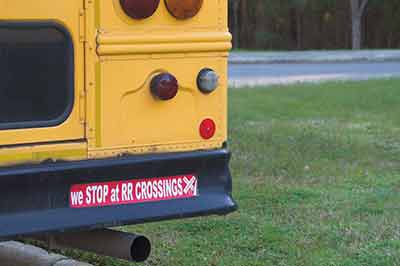The School Safety Planning Manual: Essential Resources for Developing a Comprehensive Safe School Plan developed to assist the K–12 public school system to create and implement safety plans in compliance with both state and federal laws. The 2007 Washington State legislature radically altered existing laws dealing with school safety plans, requiring a range of specific elements to each school’s plan, and the processes which must be developed and maintained to facilitate these plans.
Tag: School Safety
TRAFFIC OPERATIONS AND SAFETY AT SCHOOLS: RECOMMENDED GUIDELINES
This report contains the recommended school site planning guidelines for site selection, general site requirements and design, school bus-related design and operations, parent drop-off/pick-up zones, pedestrian and bicycle access, driveways, turn lanes, traffic control, signing and marking, and parking. The research team based these guidelines on a comprehensive review of existing guidelines and the results of field studies at school sites in Texas. The report documents the recommended guidelines and best practices for transportation operations and safety within school sites – focusing on the parent and bus drop-off/pick-up zones. The report also contains a site plan review checklist tool that TxDOT engineers and school district representatives can use to facilitate good site planning and design.
TRAFFIC OPERATIONS AND SAFETY AT SCHOOLS: RECOMMENDED GUIDELINES
This report contains the recommended school site planning guidelines for site selection, general site requirements and design, school bus-related design and operations, parent drop-off/pick-up zones, pedestrian and bicycle access, driveways, turn lanes, traffic control, signing and marking, and parking. The research team based these guidelines on a comprehensive review of existing guidelines and the results of field studies at school sites in Texas. The report documents the recommended guidelines and best practices for transportation operations and safety within school sites – focusing on the parent and bus drop-off/pick-up zones. The report also contains a site plan review checklist tool that TxDOT engineers and school district representatives can use to facilitate good site planning and design.
IOWA SCHOOL SAFETY GUIDE 2012
This document was developed for the schools of Iowa to use as a template to enhance current school safety programs; the creation of this document was a partnered effort at the state level between the aforementioned agencies. The purpose of this document is to give school districts and individual schools a planning resource to use when creating their school safety plans. Ultimately, schools can decide how much of this document they would like to incorporate into their current plan. The original document was created by the Minnesota Department of Homeland Security, and its use was granted to Iowa Homeland Security in 2011. Iowa pulled together a panel of experts to make this document specific to Iowa’s schools, and laws.
It’s important to note the partnership created by this document is intended to continue through information sharing in relation to critical assets, infrastructure protection, and school safety. Iowa Homeland Security is a representative in the Iowa Department of Public Safety, Division of Intelligence Fusion Center. This partnership allows for streamlined information sharing to the critical infrastructure owner/operators across the state. The current plan for information sharing is through the Iowa Homeland Security and Emergency Management, Threat Information and Infrastructure Protection Program (TIIPP) to the Iowa Department of Education for processing and dissemination statewide. Depending on the type of information being released it could be specific to a school, district or the education sector statewide.
COMPREHENSIVE SCHOOL SAFETY PLAN: San Bruno Park School District
Parkside Intermediate is one of eight schools in the San Bruno Park School District with traditions dating back one hundred years. Parkside Intermediate has a diverse pupil body and is served by a dedicated staff. Both staff and parents comment on the positive changes that are ongoing in our school.
Parkside Intermediate faces challenges in maintaining a safe school. This section of the Comprehensive School Safety Plan will describe programs in place at our school as well as strategies and programs of our school site council for continued improvement in providing a safe, orderly, school environment conducive to learning.
San Francisco Unified School District Emergency Operations Plan
The City and County of San Francisco (CCSF) Department of Emergency Management (DEM) and the San Francisco Unified School District (SFUSD) have initiated the process of updating the 2001 SFUSD Emergency Operations Plan (EOP). California public schools are required to comply with California Education Code (CEC), Section 35294, which deals with the preparation of ―safe school plans.‖ These plans address violence prevention, emergency preparedness, traffic safety, and crisis intervention.
As an independent agency answering to the State of California, SFUSD would normally establish an Emergency Operations Center (EOC) for the management and coordination of emergency response and recovery activities within the District. Some of the important benefits of operating an EOC include direct access to the California Emergency Management Agency (CalEMA) in applying for reimbursement following a catastrophic incident and, of course, in maintaining the District’s autonomy. However, since the District boundaries and area of responsibility are contiguous with that of CCSF, and considering the enormous capabilities and resources CCSF brings to an emergency or disaster, it is in the best interests of the District to interface directly with the CCSF Incident Command System (ICS). The most efficient method for accommodating this relationship is to establish a Department Operations Center (DOC) so that the authority of the Superintendent of Schools is in no way undermined, and the ability to efficiently respond to the emergency and save lives and property is enhanced
School Safety/Emergency Operations Plan: Ohio
Ohio schools must have a comprehensive school emergency management plan that addresses their response not only to severe weather and natural disasters, chemical accidents and medical emergencies, but also to school violence and various types of terrorist threats.
This model plan (the Plan), when used in conjunction with the Guide for Developing High-Quality School Emergency Operations Plans (the Guide) includes comprehensive information and descriptions of the overall concept of operations, organization, roles and responsibilities, along with checklists, to guide schools and school personnel in addressing various emergency hazards that may affect the safety of our children and school community.
District School Safety Plan: Falconer Central School District
The Falconer Central School District-wide School Safety Plan was developed pursuant to Commissioner's Regulation 155.17. At the direction of the Falconer Central School District Board of Education, the Superintendent of Falconer Central School District appointed a District-wide School Safety Team and charged it with the development and maintenance of the District-wide School Safety Plan.
GLOUCESTER COUNTY SPECIAL SERVICES SCHOOL DISTRICT: SCHOOL SAFETY PLAN
The Board of Education and the District’s Superintendent recognize their responsibility to provide students and staff with a safe and healthy learning environment. In keeping with this responsibility, the Superintendent directed the development of a Comprehensive District-Wide School Safety Health and Safety Plan.
After reviewing existing safety practices, the District Safety Committee recommended that individual shop safety activities be expanded and a new plan modeled after the Environmental and Occupational Health Science Institute’s (EOHSI) Safe School Project be developed.
Safe schools is a project supported by the New Jersey Department of Education, Office of vocational-Technical, Career and Innovative Programs, to assist schools in meeting environmental and occupational safety and health regulations and protecting students and staff from occupational injuries and illnesses.
The District-wide School Safety Plan is reviewed annually and updated on an as-needed basis. The Plan is contained in the District’s QAAR which is approved annually by the Board of Education prior to submission to the Office of the County Superintendent of Schools.
COMPREHENSIVE SCHOOL DISTRICT SAFETY PLAN: Island Trees UFSD
The Island Trees School District Comprehensive School Safety Plan (as required by the SAVE Law – Safe Schools Against Violence in Education – Commissioner of Education Regulars 155.17) has been established to provide for the safety, health and security of both students and staff and allows for input from the entire school community. This particular component of Project SAVE is a comprehensive planning effort that addresses risk reduction/prevention, response and recovery with respect to a variety of emergencies which may occur in the school district and its component school buildings.











